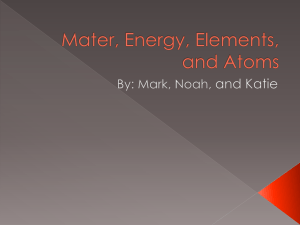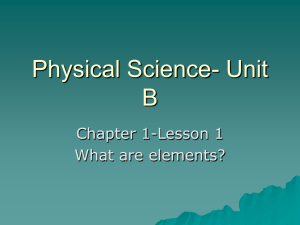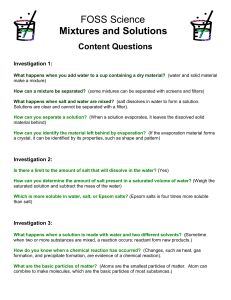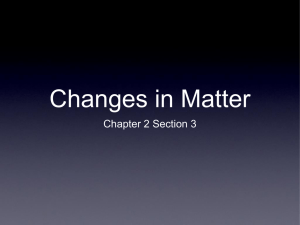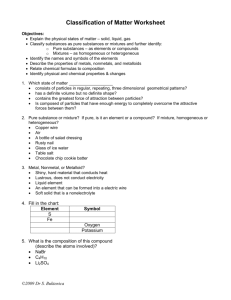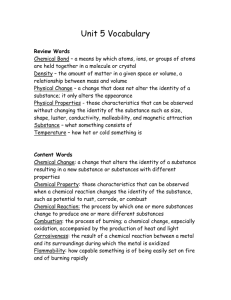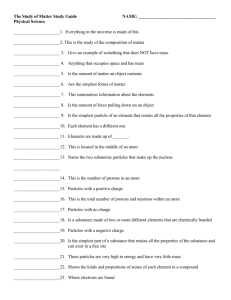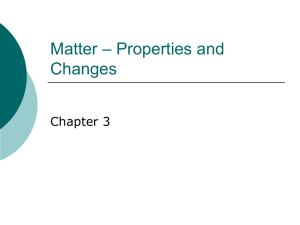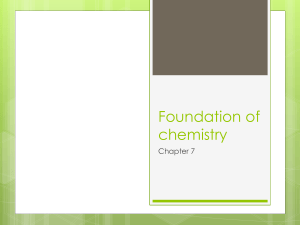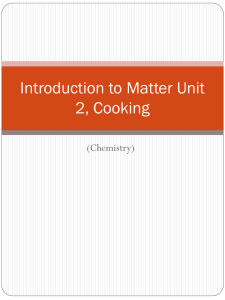Intro to Matter Chp 2
advertisement
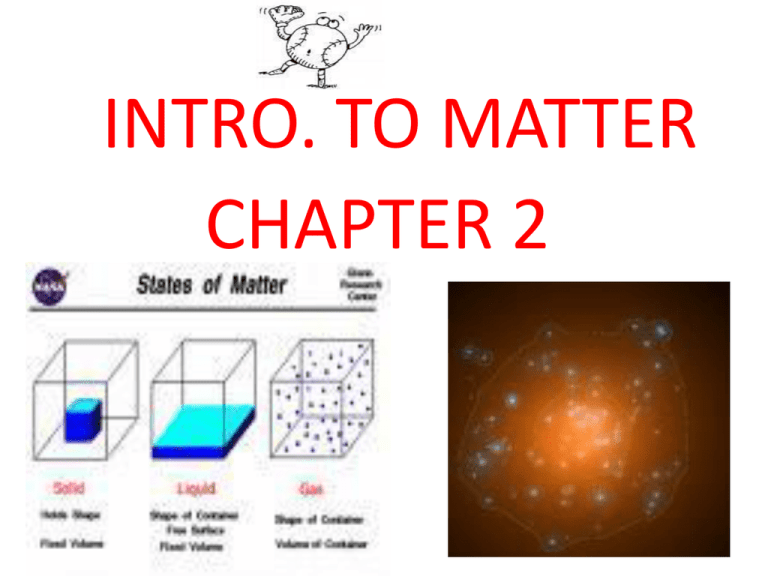
INTRO. TO MATTER CHAPTER 2 • Is what the universe is made of. • Anything that occupies space (volume) & has weight (mass). • We use our senses to become familiar with matter. CHEMISTRY The study of the properties of matter and how matter changes. Property • A characteristic that describes an object • Specific Properties- tells how matter is different. Color, Odor, Size, Shape, Texture Red apple/green apple • General Property- tells how all matter is alike. • Mass, Weight, Volume, & Density. • 1. Physical Property • 2. Chemical Property • A characteristic of a substance that can be observed w/out changing the substance. • Ripping paper up, phase changes, texture, color. Physical Property Examples •Color, odor, texture, hardness, phase changes, and ability to dissolve. • A property that describes how a substance changes into a new substance •Chemical properties help identify gases & other substances Chemical Properties: 1. Flammability- ability to burn, when H combines with O = burn 2. Rusting- O & water work on the metal to make Iron Oxide or Rust. • An element is the simplest pure substance. It can’t be changed into a simpler substance by heating or chemical means. • Iron, Aluminum, Gold, Carbon Identifying Elements •Can be identified by its specific physical and chemical properties. Periodic Table of Elements • Chemical Symbols • A shorthand way to represent elements (easy) • Consists of 1 or 2 letters from the elements name. • Oxygen= O, Carbon= C, Hydrogen= H Smallest particle of an element that has all the properties of that element. • Atoms are able to combine with other atoms. Chemical bond holds atoms together. • Pure substances made up of more than one element. 2 elements chemically combined. • Salt, Water, TNT • Can be broken down into simpler substances. Compound Properties • Compounds have properties different from the properties of the elements in them. • Water & Salt are pure substances, but they are not elements because they can be broken down into simpler substances. • Salt (NaCl) you put on french fries to add taste, but those elements alone act differently. • Sodium (Na) is a silvery metal that explodes in water, & Chlorine (Cl) is a yellowish gas that is poisonous. • Matter that consists of two or more substances mixed together, but not chemically combined. • Each substance has its own identity • Same particles are present before & after mixing. • Can be separated easily (physically). • Examples: cereal, hoagie, granite • Mixtures are classified according to how well they are mixed. • 3 Types of Mixtures: Heterogeneous, Homogeneous, & Solutions. • Least Mixed • Parts of a mixture are easily seen & can be separated easily. • Tacos, hoagie, cereal • Well mixed • Particles are very small & not easily recognizable. • Stainless steel, milk, tanning lotion • Best mixed of all mixtures • A type of homogeneous mixture where one substance dissolves in another. • Ocean water, air, lemonade • Evaporation • Electrolysis • Filtering WEIGHT VS MASS • Mass- the amount of matter in an object • WEIGHT-the measure of force attraction between 2 objects due to gravity VOLUME • the amount of space an object takes up. Can be expressed in L, ml, or cm. • Volume = length X width X height • Can also submerge object. • Mass per unit volume. Stuff inside. • Compares different types of matter. Steel vs Wood • Density= Mass/Volume • Expressed g/ml or g/cm3 Example •If 100 g of steel has a volume of 5cm3, what’s the density? D=M/V D= 100g/5cm3 D= 20g/cm3 • Any change that alters the form or appearance of matter, but does not make a different substance. • Can– can crush, flatten, chop it, BUT it is still a can! • Change state(solid to liquid, liquid to gas…) • Change in shape or form- bend, crush, chop, dissolve, break… • A change in matter that produces a new substance with properties different from the original substance. (chemical reaction) • Combustion, Electrolysis, Oxidation, Rusting, Tarnishing. Chemical Change Examples • Water is a combo of the elements hydrogen (H) & oxygen (O). • Made of 2 atoms of hydrogen & 1 atom of oxygen. • Salt is a combo of sodium (Na) & chlorine (Cl) that you put on frenchfries to add taste, but those elements alone act differently. • Sodium (Na) is a silvery metal that explodes in water, & Chlorine (Cl) is a yellowish gas that is poisonous. • Matter cannot be created nor destroyed in any physical or chemical change. • No mass is lost during a change. • Atoms are rearranged. • Ability to do work or cause change. • Every chemical or physical change in matter includes a change in energy. • Temp is average energy of motion of particles. • Thermal energy is TOTAL energy of all particles in object. • Not same, but temp is related to the amount of thermal energy an object has. • When matter changes, the most common type of energy released or absorbed is thermal energy. • Ice melting- ice absorbs thermal energy from air & sun. object absorbs energy, ice melting. object releases energy, combustion. • Kinetic- energy in motion • Potential- stored energy • Chemical- energy stored in matter (chemical bonds). • Electromagnetic- energy in form of waves • Electrical- energy of electrically charged particles • Thermal- total energy motion • During a chemical change, chemical energy may be changed to other forms of energy. • Photosynthesis: Plant convert electromagnetic energy from the sun to chemical energy to make sugars (food).
